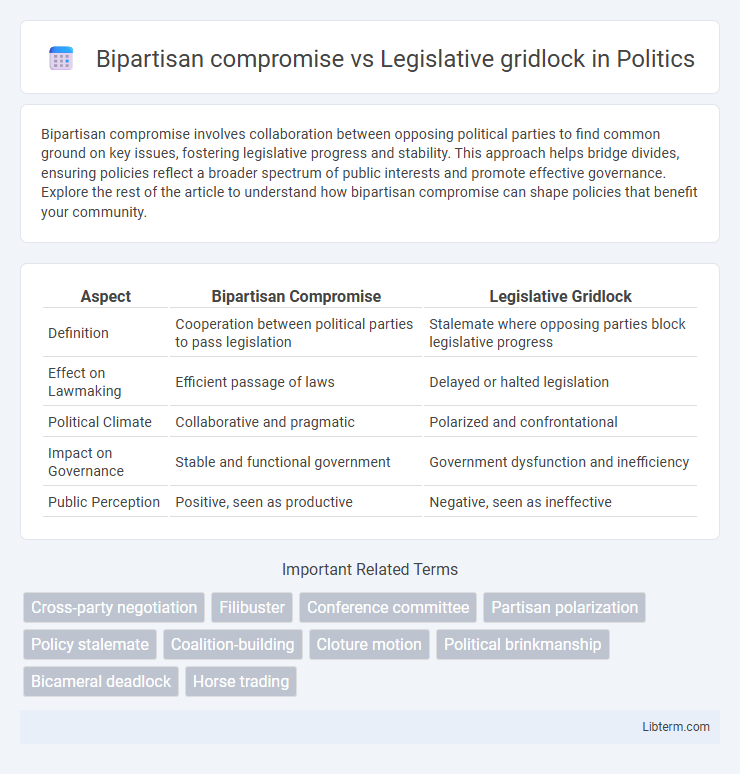Bipartisan compromise involves collaboration between opposing political parties to find common ground on key issues, fostering legislative progress and stability. This approach helps bridge divides, ensuring policies reflect a broader spectrum of public interests and promote effective governance. Explore the rest of the article to understand how bipartisan compromise can shape policies that benefit your community.
Table of Comparison
| Aspect | Bipartisan Compromise | Legislative Gridlock |
|---|---|---|
| Definition | Cooperation between political parties to pass legislation | Stalemate where opposing parties block legislative progress |
| Effect on Lawmaking | Efficient passage of laws | Delayed or halted legislation |
| Political Climate | Collaborative and pragmatic | Polarized and confrontational |
| Impact on Governance | Stable and functional government | Government dysfunction and inefficiency |
| Public Perception | Positive, seen as productive | Negative, seen as ineffective |
Understanding Bipartisan Compromise: Definition and Importance
Bipartisan compromise involves collaboration between members of different political parties to create mutually acceptable legislation, ensuring effective governance and policy-making. This approach reduces legislative gridlock by enabling the passage of bills that address diverse interests and promote national stability. Understanding bipartisan compromise is crucial for recognizing how political cooperation fosters productive outcomes in a polarized environment.
The Mechanics of Legislative Gridlock
Legislative gridlock occurs when opposing political parties fail to reach agreement, resulting in stalled policy-making and delayed government action. The mechanics of gridlock often involve filibustering, party polarization, and rigid committee structures that inhibit consensus-building and legislative progress. Bipartisan compromise counters these barriers by fostering negotiation and mutual concessions, enabling the passage of critical bills despite deep partisan divides.
Historical Examples of Successful Bipartisan Efforts
The Civil Rights Act of 1964 exemplifies bipartisan compromise, with key support from both Republicans and Democrats overcoming deep political divides. Another landmark bipartisan achievement was the Tax Reform Act of 1986, which simplified the tax code through cooperation between President Ronald Reagan and Congress. These historical examples demonstrate that bipartisan efforts can break legislative gridlock by aligning diverse political interests towards common goals.
Causes and Consequences of Political Gridlock
Political gridlock often stems from intense partisan polarization and an evenly divided government, causing legislative stalemates that prevent the passage of critical laws. Causes include ideological differences, strategic obstruction by minority parties, and procedural hurdles such as filibusters. Consequences of gridlock include delayed policy responses, government shutdowns, and increased public frustration, undermining democratic governance and eroding trust in political institutions.
Key Benefits of Bipartisan Compromise in Governance
Bipartisan compromise in governance fosters policy stability by incorporating diverse viewpoints, which leads to more sustainable and widely accepted legislation. It enhances government efficiency by breaking legislative gridlock, enabling timely decision-making on critical issues such as healthcare, infrastructure, and national security. This cooperation also strengthens public trust by demonstrating lawmakers' commitment to prioritizing national interests over partisan conflicts.
Popular Legislation Blocked by Gridlock
Legislative gridlock often stalls popular legislation such as criminal justice reform and infrastructure bills, despite widespread public support across party lines. Bipartisan compromise facilitates the passage of essential policies by bridging ideological divides and promoting cooperative decision-making. Persistent gridlock undermines democratic responsiveness, leaving critical reforms unaddressed and eroding public trust in government effectiveness.
Strategies to Foster Bipartisan Collaboration
Effective strategies to foster bipartisan collaboration include establishing regular, structured dialogues between party leaders to build trust and find common ground on key issues. Implementing bipartisan committees with equal representation encourages shared responsibility and accountability in the legislative process. Emphasizing data-driven policy-making and promoting transparent communication channels helps bridge ideological divides and reduce legislative gridlock.
How Gridlock Affects Public Policy and Everyday Life
Legislative gridlock often stalls critical policy decisions, delaying funding for infrastructure, healthcare, and education, which directly impacts public services and economic growth. When lawmakers fail to reach bipartisan compromise, vital reforms remain unaddressed, exacerbating social inequality and public dissatisfaction. The resulting policy stagnation reduces governmental responsiveness, undermining citizens' trust and hindering effective governance.
Case Studies: Bipartisanship vs. Gridlock in Recent Politics
The 2018 federal budget agreement exemplifies bipartisan compromise, as Democrats and Republicans collaborated to increase spending caps and avoid a government shutdown. In contrast, the failure to pass comprehensive immigration reform in 2013 illustrates legislative gridlock, where partisan divisions prevented consensus despite widespread public support. These case studies highlight the impact of political polarization on legislative productivity and policy outcomes in recent U.S. politics.
The Future: Can Bipartisan Compromise Break the Gridlock?
Bipartisan compromise offers a potential pathway to overcome legislative gridlock by fostering cooperation between major parties on critical policy issues such as infrastructure, healthcare, and climate change. Historical examples demonstrate that bipartisan efforts can result in significant legislation, indicating that renewed dialogue and negotiation could revitalize congressional productivity. The future depends on willingness from political leaders to prioritize common goals over partisan agendas, leveraging bipartisan frameworks to address national challenges effectively.
Bipartisan compromise Infographic

 libterm.com
libterm.com